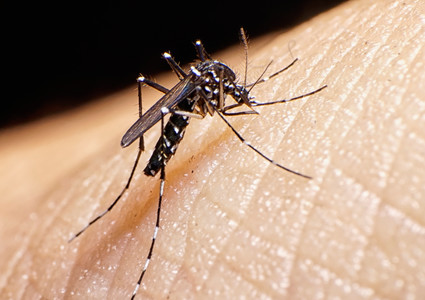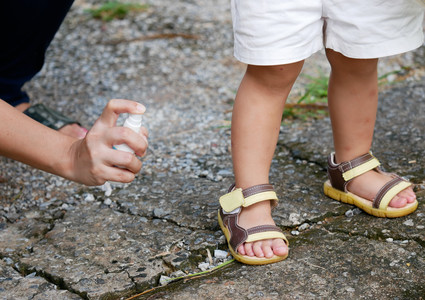




Today's Medicine
Mosquitoes, Ticks and Spiders: The Creepy-Crawly Hazards of Summer
Published: July 15, 2020

Those Pesky Arthropods
Arthropods are six-legged insects (like mosquitoes) and eight-legged arachnids (like spiders, ticks and mites).
Mosquitoes, ticks and mites survive on the blood of vertebrates. Most rely on their sense of smell to locate a warm-blooded animal. After finding their prey, they can be very good at staying in place and puncturing an animal’s skin to get that bloody meal.

The Trouble With Mosquitoes
Mosquitoes carry some very serious diseases in the Unites States and even more abroad.
The most prevalent native disease is West Nile virus. Only a small number of people who contract it become very sick. But some sufferers, especially the elderly and those with impaired immune systems, can develop severe encephalitis (inflammation of the brain), which can lead to permanent disability or even death. There is no treatment for West Nile, so prevention is key.
Much rarer are arboviruses (arthropod-borne viruses) that are more regional in nature, such as La Crosse encephalitis, which strikes roughly a hundred people a year in the upper Midwest. These viruses tend to start causing disease in midsummer and peak in incidence in late August or early September.
If you’re traveling outside the U.S., be aware that mosquitoes can transmit serious diseases, including:
The only vaccines for mosquito-borne infections are for yellow fever and Japanese encephalitis (JE). They should be considered for travelers going to endemic areas (South America and Africa for yellow fever, and Asia for JE) in warmer months. Travel medicine specialists, like the doctors at the Methodist Travel Clinic, can administer vaccines and prescribe medication to prevent malaria.
Do Mosquitoes Find You Attractive?
Why do some people seem to be especially susceptible to mosquito bites?
There are several reasons:
- Blood type O has been determined to be more attractive to mosquitoes than other blood types.
- Mosquitoes are attracted to lactic acid, uric acid and other substances that are released when you sweat; the excretion of some of these compounds differs from person to person and is often influenced by genetics.
- Larger people and pregnant women excrete more carbon dioxide, which attracts mosquitoes.
- Wearing clothes that contrast with the background, e.g., red or black, makes a target stand out to mosquitoes, which use sight to a limited degree to find a blood source.
Don’t Forget About Ticks
While mites, fleas and the human body louse can transmit disease, it’s uncommon in developed countries like the U.S.
Ticks, however, are extremely prevalent and transmit a number of diseases. Rocky Mountain spotted fever (RMSF) and a similar illness called ehrlichiosis occur across the midsection of the country. These conditions are transmitted by the bite of a large tick like the wood tick or lone star tick. The lone star tick has also been linked to alpha-gal syndrome, an allergy to red meat.
Deer ticks can transmit anaplasmosis, Lyme disease and a parasitic infection similar to malaria called babesiosis. These diseases are mainly confined to the northeastern U.S., the upper Midwest (especially Minnesota and Wisconsin) and the Pacific Northwest, although the range seems to gradually increase year by year.
RMSF, ehrlichiosis, anaplasmosis and Lyme disease all respond to basic antibiotics, especially if caught at an early stage. But preventing a tick bite is the easier course of action.
Spider Bites: Rare but Risky
One other arthropod of note that can bedevil humans is the spider. There are only two species in the U.S. that cause a major reaction—the black widow spider and brown recluse spider. Fortunately, spiders live in out-of-the-way places and avoid large animals, and bites are very rare.

Preventing Bites
Take these steps to protect yourself from mosquitoes, ticks and more:
- Apply an insect repellant. The best repellants contain DEET, picaridin, IR3535 or some oil of lemon eucalyptus and p-Menthane-3,8-diol products. Just be sure to use any repellants according to the directions on the label. If you plan to apply sunscreen and repellant, apply the sunscreen first. Products that combine sunscreen and repellant are not recommended. Treat your clothing and gear with repellent containing 0.5% permethrin.
- Wear long sleeves and pants. If weather permits, wear loose long-sleeved shirts, pants, shoes and socks when outdoors. Light-colored clothing makes bugs easier to spot.
- Stay inside during peak mosquito hours. Avoid outdoor activity around dawn and dusk, when mosquitoes are most active.
- Remove standing water. Standing water, like that in bird baths, ponds and puddles, are mosquito breeding grounds. If stagnant water cannot be removed, report it to the health department for treatment.
After coming indoors:
- Immediately check for ticks, especially under the arms, in and around the ears, inside the belly button, behind the knees, between the legs, around the waist, and on the hairline and scalp. Don’t forget to check your pets
- Check your clothing and gear for ticks
- Shower

More Resources
- Get outside! 4 reasons why heading outdoors is good for your health
- Planning a trip? Here’s when to visit the Methodist Travel Clinic
- Like what you see? Sign up for the Bestcare Today email newsletter


